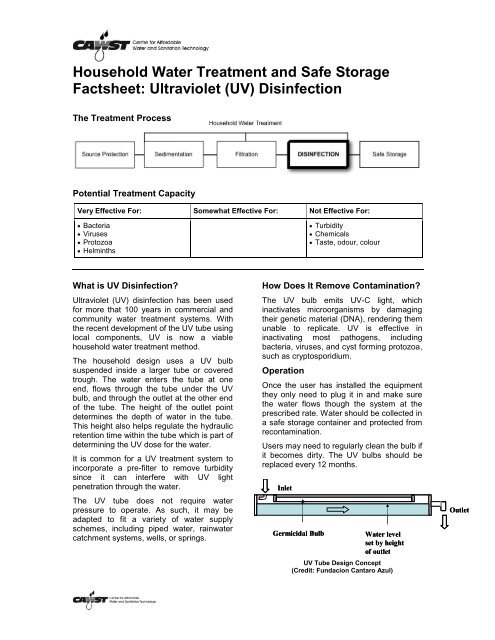Household Water Treatment and Safe Storage Factsheet: Source ...
Household Water Treatment and Safe Storage Factsheet: Source ...
Household Water Treatment and Safe Storage Factsheet: Source ...
You also want an ePaper? Increase the reach of your titles
YUMPU automatically turns print PDFs into web optimized ePapers that Google loves.
<strong>Household</strong> <strong>Water</strong> <strong>Treatment</strong> <strong>and</strong> <strong>Safe</strong> <strong>Storage</strong><br />
<strong>Factsheet</strong>: Ultraviolet (UV) Disinfection<br />
The <strong>Treatment</strong> Process<br />
Potential <strong>Treatment</strong> Capacity<br />
Very Effective For: Somewhat Effective For: Not Effective For:<br />
Bacteria<br />
Viruses<br />
Protozoa<br />
Helminths<br />
Turbidity<br />
Chemicals<br />
Taste, odour, colour<br />
What is UV Disinfection?<br />
Ultraviolet (UV) disinfection has been used<br />
for more that 100 years in commercial <strong>and</strong><br />
community water treatment systems. With<br />
the recent development of the UV tube using<br />
local components, UV is now a viable<br />
household water treatment method.<br />
The household design uses a UV bulb<br />
suspended inside a larger tube or covered<br />
trough. The water enters the tube at one<br />
end, flows through the tube under the UV<br />
bulb, <strong>and</strong> through the outlet at the other end<br />
of the tube. The height of the outlet point<br />
determines the depth of water in the tube.<br />
This height also helps regulate the hydraulic<br />
retention time within the tube which is part of<br />
determining the UV dose for the water.<br />
It is common for a UV treatment system to<br />
incorporate a pre-filter to remove turbidity<br />
since it can interfere with UV light<br />
penetration through the water.<br />
The UV tube does not require water<br />
pressure to operate. As such, it may be<br />
adapted to fit a variety of water supply<br />
schemes, including piped water, rainwater<br />
catchment systems, wells, or springs.<br />
How Does It Remove Contamination?<br />
The UV bulb emits UV-C light, which<br />
inactivates microorganisms by damaging<br />
their genetic material (DNA), rendering them<br />
unable to replicate. UV is effective in<br />
inactivating most pathogens, including<br />
bacteria, viruses, <strong>and</strong> cyst forming protozoa,<br />
such as cryptosporidium.<br />
Operation<br />
Once the user has installed the equipment<br />
they only need to plug it in <strong>and</strong> make sure<br />
the water flows though the system at the<br />
prescribed rate. <strong>Water</strong> should be collected in<br />
a safe storage container <strong>and</strong> protected from<br />
recontamination.<br />
Users may need to regularly clean the bulb if<br />
it becomes dirty. The UV bulbs should be<br />
replaced every 12 months.<br />
Inlet<br />
Germicidal Bulb<br />
<strong>Water</strong> level<br />
set by height<br />
of outlet<br />
UV Tube Design Concept<br />
(Credit: Fundacion Cantaro Azul)<br />
Outlet
















